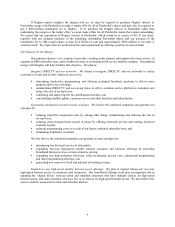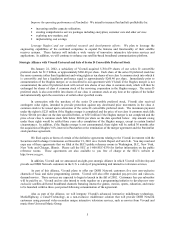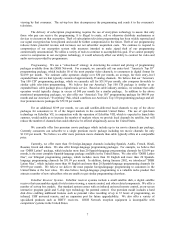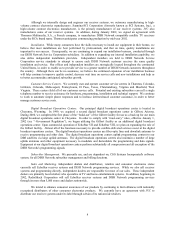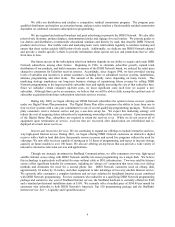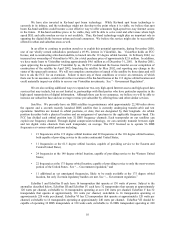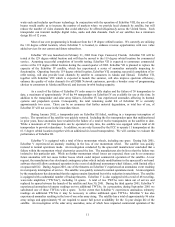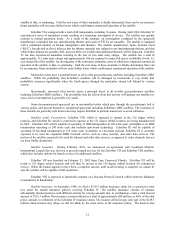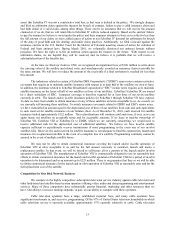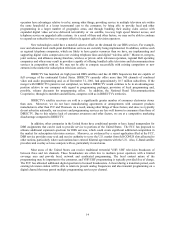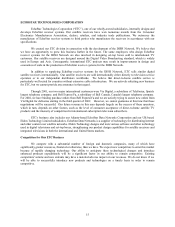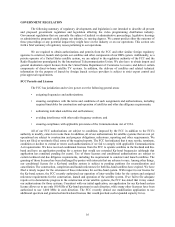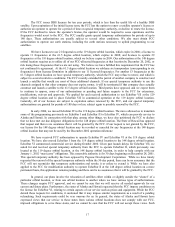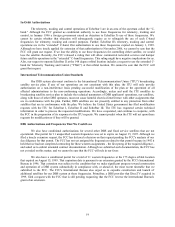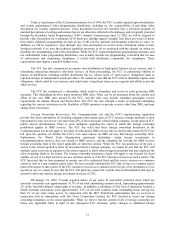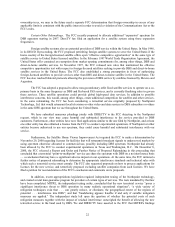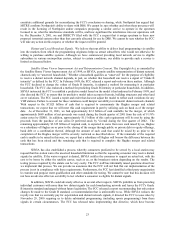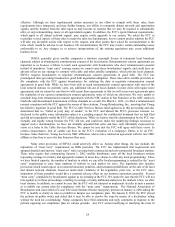Dish Network 2001 Annual Report Download - page 16
Download and view the complete annual report
Please find page 16 of the 2001 Dish Network annual report below. You can navigate through the pages in the report by either clicking on the pages listed below, or by using the keyword search tool below to find specific information within the annual report.14
operators have advantages relative to us by, among other things, providing service to multiple television sets within
the same household at a lesser incremental cost to the consumer, by being able to provide local and other
programming in a larger number of geographic areas, and through bundling their analog video service with
expanded digital video services delivered terrestrially or via satellite, two-way high speed Internet access, and
telephone service on upgraded cable systems. As a result of these and other factors, we may not be able to continue
to expand our subscriber base or compete effectively against cable television operators.
New technologies could have a material adverse effect on the demand for our DBS services. For example,
new and advanced local multi-point distribution services are currently being implemented. In addition, entities such
as regional telephone companies, which are likely to have greater resources than we have, are implementing and
supporting digital video compression over existing telephone lines and digital “wireless cable.” Moreover, mergers,
joint ventures, and alliances among franchise, wireless or private cable television operators, regional Bell operating
companies and others may result in providers capable of offering bundled cable television and telecommunications
services in competition with us. We may not be able to compete successfully with existing competitors or new
entrants in the market for subscription television services.
DIRECTV has launched six high powered DBS satellites and has 46 DBS frequencies that are capable of
full coverage of the continental United States. DIRECTV currently offers more than 300 channels of combined
video and audio programming and, as of December 31, 2001, had approximately 10.7 million subscribers. If the
merger with DIRECTV’s parent is not completed, we believe DIRECTV would continue to be in an advantageous
position relative to our company with regard to programming packages, provision of local programming and,
possibly, volume discounts for programming offers. In addition, the National Rural Telecommunications
Cooperative, through its members and affiliates, competes with us in DIRECTV’s territories.
DIRECTV’s satellite receivers are sold in a significantly greater number of consumer electronics stores
than ours. Moreover, we do not have manufacturing agreements or arrangements with consumer products
manufacturers other than JVC and Thomson. As a result, among other things of these factors, and since we typically
do not advertise nationally, our receivers and programming services are less well known to consumers than those of
DIRECTV. Due to this relative lack of consumer awareness and other factors, we are at a competitive marketing
disadvantage compared to DIRECTV.
In addition, other companies in the United States have conditional permits or have leased transponders for
DBS assignments that can be used to provide service to portions of the United States. The FCC has proposed to
allocate additional expansion spectrum for DBS services, which could create significant additional competition in
the market for subscription television services. Moreover, as evidenced by a recent application filed at the FCC,
DBS service providers may seek and receive authority to serve the U.S. market from full-CONUS slots allocated to
other nations, particularly where such nations have entered bilateral agreements with the U.S. Also, C-Band satellite
providers and overlay services compete with us, particularly in rural areas.
Most areas of the United States can receive traditional terrestrial VHF/ UHF television broadcasts of
between three and ten channels. These broadcasters are often low to medium power operators with a limited
coverage area and provide local, network and syndicated programming. The local content nature of the
programming may be important to the consumer, and VHF/UHF programming is typically provided free of charge.
The FCC has allocated additional digital spectrum to licensed broadcasters. At least during a transition period, each
existing television station will be able to retain its present analog frequencies and also transmit programming on a
digital channel that may permit multiple programming services per channel.


